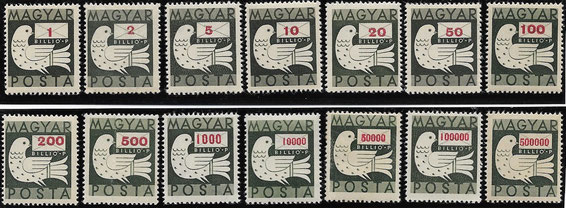Pengö / Hyperinflation
After Work War II, Hungary experienced a galloping hyperinflation in 1945/46 with its then Pengö currency. This reached its climax in July 1946. Between Juky 3, 1946, and July 13, 1946, a definitive stamp set with face values of 1 trillion Pengö (=1x1012, issued 3/7) up to 500 quadrillion Pengö (=5x1017, issued 13/7) was issued. In an attempt to stabilize the currency, the Tax-Pengö (adopengö) was introduced as alternative currency.
On July 15, 1946, a commemorative stamp set (“100 years railway”) was issued with face values between 10000 and 40000 adopengö, followed by definitives between July 16, and July 26, with face values of 5000 adopengö (issued July 16) up to 5 million adopengö (July 26). But the adopengö could not stop the devaluation, which triggered a currency reform on August 1, 1946, replacing the Pengö and adopengö with the new Forint currency. The exchange rate for the new to old currency was defined as 1 Forint = 400 octillion Pengö (=4x1029 Pengö) = 200 million adopengö.
With stamp quantities of 568000 sets for the first definitives, 949620 sets for the second definitives (both valid until July 13 and July 31 respectively) and 94324 sets for the commemorative stamps (valid until July 31) the quantities issued were rather high given the short duration of validity.
Pengö definitive stamps (July 3 to July 13)
adopengö commemorative stamps "100 years railway"
adopengö definitive stamps (July 16 to July 26)
Withdrawn, controversial and exceptional stamps and other withdrawn postally issued items
| * | = | Withdrawn |
|---|---|---|
| ** | = | Controversial |
| *** | = | Exceptional |
| **** | = | Unclear |
Diese Webseite wurde mit Jimdo erstellt! Jetzt kostenlos registrieren auf https://de.jimdo.com





